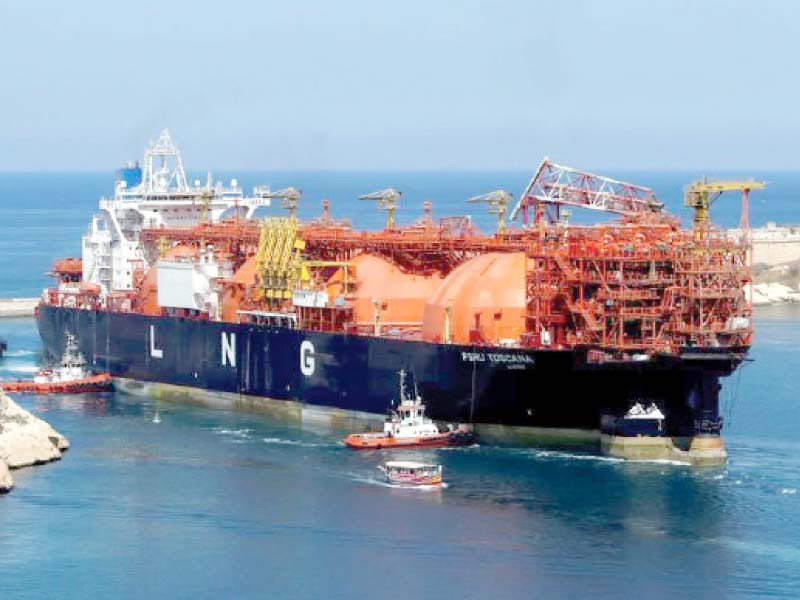
KARACHI:
Pakistan currently imports liquefied natural gas (LNG) through a government-to-government agreement (15-year contract with Qatar on a take-or-pay basis) and four arrangements with private vendors in Italy and Qatar (also term contracts on take-or-pay basis).
Over the last three years, these term agreements have accounted for more than 87% of all LNG shipped into Pakistan. The remainder 13% was made up of spot purchases to meet demand that exceeded the term commitment.
Talk of the town is that Pakistan is going to face the shortage of LNG because it is now getting attracted towards the European and US markets.
But was Pakistan’s structural framework capable enough to benefit the most out of the LNG, when LNG didn’t find its new love in the European and US markets?
According to projections of the Ministry of Energy and Ogra, Pakistan’s indigenous supply will barely meet 22.3% of the market demand by 2030.
Adding fuel to the crisis is the EU ban on Russian petro products due to its Ukrainian adventure. The demand for LNG has spiked after suppliers found new buyers in the much attractive settings in the likes of the EU, UK and US.
“We should try to get as many long-term contracts as we can, they are still in the range of 11-13% of the crude price,” said Ammar Habib Khan, Chief Risk Officer at Karandaaz Pakistan.
“It can ensure stability and help avoid the volatility associated with the spot market. The demand for gas will only continue to increase.”
According to the State Bank’s report, at the moment, two Floating Storage and Regasification Units (FSRUs) have a government-contracted potency of almost 600 million cubic feet per day (mmcfd) each (take-or-pay). The two units have implanted regasification capacities of 690 mmcfd and 750 mmcfd respectively.
Engro Elengy receives six LNG cargoes per month on average, totalling 19 million British terminal units (mmbtu), which is roughly equivalent to the terminal’s contractual capacity.
However, in the case of Pakistan LNG Limited (PLL), the average capacity utilisation since its inception has been 65%, with three to four cargoes dry dock each month.
The government is currently the exclusive player in the LNG import business. The LNG supply chain process typically begins with an estimate of LNG trend from end-users such as the power industry (including captive power plants), general industries, transportation, and households.
Sui companies, in specific, are primarily responsible for predicting the future gas requirements by various consumer bits. Sui companies present their forecasts to the Petroleum Division, which compares the projected demand with the contractual supplies from long-term agreements and afterwards submits a formal request to PLL to acquire additional volumes from the spot market, if necessary.
PLL then places the tender on the international market and procures the required quantities.Recently, in order to ensure continuous supply of power during the Eid holidays, Pakistan spent roughly $100 million on a single LNG cargo from the spot market, a record for the cash-strapped country.
PLL, as a public organisation, is required to meet all the criteria listed in the Public Procurement Regulatory Authority (PPRA) rules and regulations. While the standards ensure transparency in the supply chain, the timeframe for the required procedures causes delay in cargo arrivals.
According to the PPRA rules, the overarching shipping procedure takes more than 60 days on average, with a 30-day period, mandated by law, for advertisement and bid filing and a 10-day mandatory duration between bid unveiling and tender grant. Contrary to this, Japan, which is one of the largest importers of LNG in Asia, introduced multiple initiatives in its LNG framework to deregulate retailing, increase competition, and lower the cost of gas. As the world’s largest importer of natural gas and LNG, Japan gets about a quarter of its energy from LNG imports from Australia, the United States, Qatar and Russia.
Natural gas is primarily consumed by power distribution companies and as urban gas, which provides the fuel to manufacturing, commercial and residential segments in Japan.
The government allowed quasi-gas companies to sell gas in any vicinity as part of the reform methodology.
The Japanese government abolished the regional dominance in the commercial sector with the Gas Business Act 2015, allowing registered companies to enter the retail market. It also repealed the tariff regulations that had earlier been levied on retail companies.
Furthermore, the government instituted a licensing system that required companies to have licences for gas production, pipeline services and gas retail business.
It motivated third-party access to LNG terminals, prohibited terminal owners from refusing third-party consumption and asked them to report and publish their annual utilisation action plan.
The government legalised the restructuring of pipeline service business and permitted new companies to use pipeline channels. This legislation mandated the legal separation of pipeline service business from major gas companies by 2022, with the overarching goal of promoting retail competition in the pipeline network, as well as the import and terminal infrastructure.
If the long-delayed Iran-Pakistan (IP) and Turkmenistan-Afghanistan-Pakistan-India (TAPI) gas pipeline initiatives do not join the network, the estimated yearly gross energy deficit between 2021 and 2030 for Pakistan will be 2,593 mmcfd. To bring this shortfall into perspective, it is 2.7 times the size of LNG purchased by the country in 2020. The problem is domestic structural incompetence. It’s going to be a harsh winter.
The writer is an expert on political economy, cities and governance, and is working as a research associate at the Centre for Social and Political Research
Published in The Express Tribune, June 27th, 2022.
Like Business on Facebook, follow @TribuneBiz on Twitter to stay informed and join in the conversation.

































































COMMENTS
Comments are moderated and generally will be posted if they are on-topic and not abusive.
For more information, please see our Comments FAQ